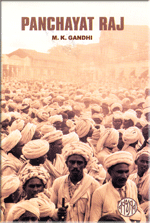
P.O. SEVAGRAM, DIST.WARDHA 442102, MS, INDIA. Phone: 91-7152-284753
FOUNDED BY MAHATMA GANDHI IN 1936
Panchayat Raj

NATURE CURE
Written by : M. K. Gandhi
Table of Contents
- Publisher's Note
- Why The Village Movement?
- Panchayats in Pre-Independence Days
- Panchayats in Independent India
- My Idea of Village Swaraj
- An Ideal Village
- Non-violent Rural Economy
- All-round Village Development
- Village Sanitation
- Rural Medical Relief
- Revival of Village Industries
- Charkha In The Villages
- Other Village Industries
- Duty of Congress Ministries
- Co-operative Cattle Farming
- Village Exhibitions
- Lok Sevak Sangh
- Samagra Gramseva
- Shanti Dals in Villages
About This Book
Written by : M. K. Gandhi
Compiled by : R. K. Prabhu
First Edition :10,000 copies, February 1959
I.S.B.N :81-7229-139-6
Printed and Published by :Jitendra T. Desai,
Navajivan Mudranalaya,
Ahemadabad-380014
India.
© Navajivan Trust, 1960
Download
Chapter-5: An Ideal Village
An ideal Indian village will be so constructed as to lend itself to perfect
sanitation. It will have cottages with sufficient light and ventilation
built of a material obtainable within a radius of five miles of it. The
cottages will have courtyards enabling householders to plant vegetables for
domestic use and to house their cattle. The village lanes and streets will
be free of all avoidable dust. It will have wells according to its needs
and accessible to all. It will have houses of worship for all, also a common
meeting place, a village common for grazing its cattle, a co-operative
dairy, primary and secondary schools in which industrial education will be
the central fact, and it will have Panchayats for settling disputes. It will
produce its own grains, vegetables and fruit, and its own Khadi. This is
roughly my idea of a model village. In the present circumstances its
cottages will remain what they are with slight improvements. Given a good zamindar, where there is one, or co-operation among the people, almost the
whole of the programme other than model cottages can be worked out at
expenditure within means of the villagers including the zamindar or
zamindars, without Government assistance. With that assistance there is no
limit to the possibility of village reconstruction. But my task just now is
to discover what the villagers can do to help themselves if they have mutual
co-operation and contribute voluntary labour for the common good. I am
convinced that they can, under intelligent guidance, double the village
income as distinguished from individual income. There are in our villages
inexhaustible resources not for commercial purposes in every case but
certainly for local purposes in almost every case. The greatest tragedy is
the hopeless unwillingness of the villagers to better their lot.
The very first problem the village worker will solve is its sanitation. It is
the most neglected of all the problems that baffle workers and that
undermine physical well-being and breed disease. If the worker became a
voluntary Bhangi, he would begin by collecting night- soil and turning it
into manure and sweeping village streets. He will tell people how and where
they should perform daily functions and speak to them on the value of
sanitation and the great injury caused by its neglect. The worker will
continue to do the work whether the villagers listen to him or not.
Harijan, 9-1-1937